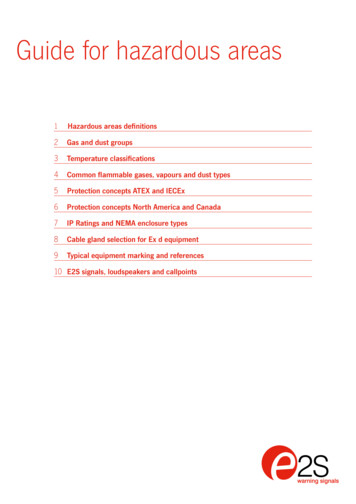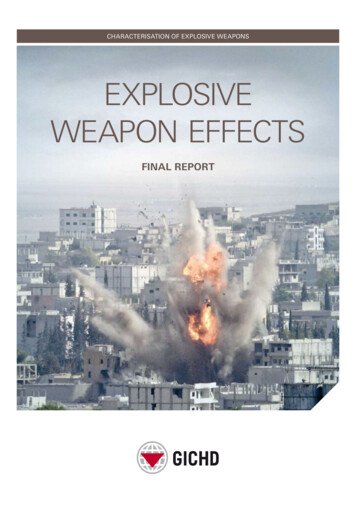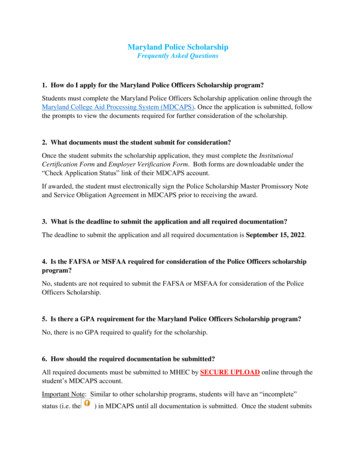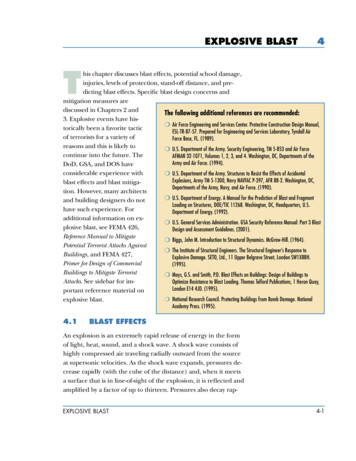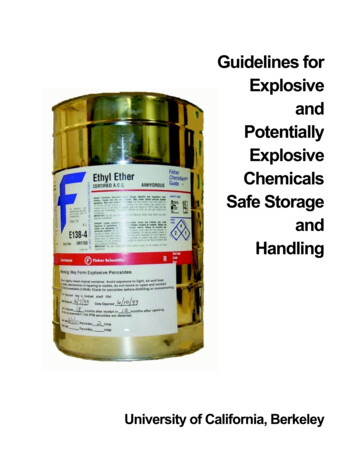
Transcription
Guidelines forExplosiveandPotentiallyExplosiveChemicalsSafe StorageandHandlingUniversity of California, Berkeley
Guidelines forExplosive and Potentially Explosive ChemicalsSafe Storage and HandlingTABLE OF CONTENTS1.2.3.4.5.Introduction . 1Common Laboratory PECs. 2General Storage Precautions . 3Sample Label . 4Specific Storage and Testing Guidelines for Peroxide FormingChemicals . 55.1 About Peroxide Forming Chemicals . 55.2. Testing Schedule for Peroxide Forming Chemicals. 6Disposal or Testing Recommendations . 65.3 An Analysis of Common Detection Proceduresfrom R.J. Kelly’s article, ”Review of Safety Guidelines forPeroxidizable Organic Chemicals“Peroxide Detection Methods . 7Ferrous Thiocyanate Method . 7Iodide Tests . 8Dip Strips . 9Titanium Sulfate . 9Summary . 10Removal of Peroxides . 10Method 1 . 10Method 2 . 10Method 3 . 11Other Methods . 11References . 11APPENDICES:Appendix I—Explosive and Potentially Explosive Chemical Families . 12Appendix II—Common Peroxide Forming Compounds . 15Appendix III—Chemicals that May Explode due to Over-pressurizedContainers . 17
1. IntroductionExplosive chemicals can release tremendous amounts of destructive energy rapidly. If nothandled properly, these chemicals can pose a serious threat to the health and safety of laboratory personnel, emergency responders, building occupants, chemical waste handlers, anddisposal companies. For example, an explosion of old isopropyl ether killed a laboratory workerwhen he attempted to remove a glass stopper from the container.1 In another instance, tetrazoleexploded inside a hazardous waste incinerator, causing major damage and costly repairs.2There are two classes of explosive chemicals. The first is known explosive chemicals that aredesigned and produced for use as an explosive (e.g., TNT, explosive bolts, bullets, blastingcaps, and fireworks). The other class is potentially explosive chemicals (PECs), which includeperoxidizable organic chemicals. Most chemicals that are used in research and teaching laboratories are stable and non-explosive at the time of purchase. Over time, some chemicals canoxidize, become contaminated, dry out, or otherwise destabilize to become PECs (e.g., isopropyl ether, sodium amide, and picric acid). See Appendix I—Explosive and PotentiallyExplosive Families— for examples.Unlike known explosives, which are designed to be stable under normal conditions, PECs areparticularly dangerous because they may explode if they are subjected to heat, light, friction,or mechanical shock. To handle and dispose of PECs properly, the University of California,Berkeley, campus uses a specialty contractor to transport the PEC to an isolated location wherethe chemical is opened by remote control. The contractor then stabilizes the chemical, makingit safe to ship and dispose of. Costs can range from 500 to 1500 per chemical for this specialhandling service.Note: There is a great deal of uncertainty regarding the hazards and safe handling of PECs.For example, with peroxide forming chemicals, there are no definite data available about theconcentration and specific conditions at which these peroxides will detonate. Several common test methods may not detect all types of unstable peroxides, and some commondeperoxidation procedures may not remove all types of unstable peroxides. Also, there areno specific federal Cal/OSHA regulations on this subject.-1-
2. Common Laboratory PECsThere are many PECs used in academic research and teaching laboratories (see appendix I).The following are some commonly used chemicals that can become an explosion hazard under certain conditions: Organic chemicals that form peroxides through exposure to air or light (see Appendix II—Peroxide Forming Chemicals) Hydrated picric acid that becomes dry or becomes contaminated with metals that formmetal picrate salts Sodium amide that reacts with air or moisture to form superoxides, as evidenced by yellowor brown discoloration Certain alkyl nitrates (e.g., butyl nitrate or propyl nitrate) that become contaminated withnitrogen oxides Certain normally stable perchlorates (e.g., pyridium perchlorate or tetraethylammoniumperchlorate) that become unstable at elevated temperaturesNote: Most explosions occur while purifying or distilling mixtures. Therefore, use extreme caution before concentrating or purifying any mixture that may contain an explosive chemical (e.g., a peroxide forming chemical or perchlorate).There is an additional group of chemicals that should be considered although they are notnecessarily heat-, light-, friction-, or shock-sensitive. These chemicals give off gaseous degradation by-products that may cause over-pressurization of the container and explode. Theycan degrade over time and should be incorporated into a safety and handling system thatwill prevent them from becoming explosive hazards.Contact EH&S immediately (642-3073) if you suspect a material is a PEC. Post warning signsso others do not handle or disturb the material. EH&S will inspect the chemical and devise anappropriate action plan to safely dispose of the chemical.-2-
3. General Storage PrecautionsIt is important that chemical users track and dispose of chemicals before they become a problem. Proper inventory management systems can help mitigate risk to personnel and averthigher than normal disposal costs. Identify all explosive and potentially explosive chemicals in your inventory. Never storeunlabeled chemicals. Before they can be shipped to a disposal site, unknown chemicalsrequire special testing to determine which hazardous properties they possess. In some cases,an unknown chemical that is not a PEC could be classified as a PEC because its outwardappearance resembles other known explosives. The handling and disposal of these chemicals costs significantly more than known chemicals. Record the opening date and the date that the chemical should be discarded onthe label of chemicals that may degrade to become potentially explosive. Labels are available from EH&S or you may use the sample label on the next page. Keep explosive chemicals away from all ignition sources such as open flames, hot surfaces,spark sources, and direct sunlight. Consider designating a special area for explosive chemical use. Store explosive chemicals inan explosive magazine, and inspect areas weekly to comply with the California Fire Code.(Contact EH&S for assistance.) Periodically check containers of chemicals that could become over-pressurized, like highlyconcentrated formic acid (See Appendix III). Note: Release the pressure by unscrewing thecap, using protective heavy-duty gloves, chemically resistant coveralls, safety glasses, faceshield, and a safety glass screen between you and the container. As part of your Chemical Hygiene Plan, make sure everyone who uses chemicalsthat are explosive or could become potentially explosive are thoroughly trained insafe storage methods, conditions to avoid (e.g., contamination), the hazards of thechemical, and disposal procedures.-3-
4. Sample LabelWarning: May Form Explosive PeroxidesStore in tightly closed original container. Avoid exposure to light, air, and heat. Ifcrystals, discoloration, or layering are visible, do not move or open the container.Contact EH&S immediately. Check for peroxides before distilling or concentrating.This Chemical Has a Limited Shelf Life!Date ReceivedDate OpenedDispose of this chemical 18 months after receipt or 12 months after opening.See “Guidelines for Explosive and Potentially Explosive Chemicals Safe Storageand Handling” at www.ehs.berkeley.edu for specific expiration dates.-4-
5. Specific Storage and Testing Guidelines for Peroxide Forming Chemicals5.1 About Peroxide Forming ChemicalsMany oxygenated organic compounds become more and more dangerous upon prolongedstorage because they tend to form explosive peroxides with age. Organic peroxides are carbon-based chemicals that contain the characteristic peroxide O-O bond. Peroxides may formin freshly distilled, undistilled, and unstabilized ethers within less than two weeks. Exposureto light and air enhances the formation of the peroxides. Many ethers tend to absorb and reactwith oxygen from the air to form unstable peroxides which may detonate with extreme violence when they become concentrated by evaporation or distillation. These ethers may alsoexplode when combined with other compounds that produce a detonable mixture or whendisturbed by heat, shock, or friction.Peroxides formed in compounds by auto–oxidation have caused many accidents, includingthe unexpected explosions of the residue of solvents after distillation. While ethers presentone of the most commonly known peroxidizable compound risks, other common solventssuch as isopropanol have exploded upon distillation due to peroxide concentration.While the peroxide formation potential in ethers is the primary hazard, ethers also poseinhalation hazards. Lower molecular weight ethers are powerful narcotics that can causedeath in large doses.With all peroxide forming chemicals it is preferable to use small containers that can be completely emptied, rather than take small amounts from a large container over time. Ethersshould be stored in amber bottles or other opaque containers and under a blanket of inert gas,such as nitrogen or argon, or over a reducing agent to inhibit formation of peroxides. Containers of ether and other peroxide forming chemicals should be marked with the date theyare opened and with the date of required disposal. Mark these dates on the container usingan indelible marker or attach a PEC warning label (such as the sample in section 4 or the labelshown on the cover of this booklet) and fill out the dates section. Labels are available fromEH&S.-5-
5.2 Testing Schedule for Peroxide Forming ChemicalsBy the expiration date, the person using a peroxide forming chemical should either disposeof it or test it for peroxide content. Dispose of any chemicals found to have a peroxide concentration greater than or equal to 100 parts per million. Chemicals that have lasted beyond therecommended shelf life but have been tested and show no detectable peroxides, or whoseperoxide concentrations are less than 100 ppm, may be retained but should be tested according to Table 1 below. Testing results should be recorded on the container. Test all peroxideformers prior to distillation, regardless of age.Never test containers of unknown age or origin. Old bottles may contain concentrated peroxides, or peroxides may have crystallized in the cap threads, which would present a serioushazard when opening the bottle for testing. Call EH&S for managing old containers.Disposal or Testing RecommendationsThe following recommendations were obtained from Prudent Practices for Disposal of Chemicalsfrom Laboratories, Appendix I, National Academy Press, Washington, DC, 1983, pp. 245-246.Table 1Storage and Disposal of Peroxidizable Organic Chemicals(See Appendix II for chemical lists A-D)Peroxidizable Chemical ClassificationUnopened chemicals from the manufactureDispose or Test After*18 monthsOpened containers***List A chemicals3 monthsList B chemicals12 monthsList C, uninhibited chemicals24 hoursList C, inhibited chemicals12 months**List D chemicals12 monthsNever open or test containers of unknown origin or age, or those that have visible evidence of peroxides!Do not store under inert atmosphere.-6-
5.3. An Analysis of Common Detection ProceduresThe following pages are a reprint of part of R. J. Kelly’s article, “Review of Safety Guidelines for Peroxidizable Organic Chemicals,” originally published in Chemical Health &Safety. Kelly’s references and a few passages (indicated by ellipses) have been omitted. (SeeReferences, page 11.)Peroxide Detection MethodsAlthough there are numerous quantitative, semiquantitative, and qualitative methods todetect peroxides in organic and aqueous solutions, four are commonly used. They includetwo qualitative variations on the iodine detection method, the qualitative ferrous thiocyanate method, and the use of semiquantitative redox dip strips. Recently, the use of titanium sulfate has been suggested as a means to detect peroxides, but it is not widely used.The dip strip method has the advantage of being the most gentle test, an important consideration if the chemical is shock sensitive. It also has another substantial advantage: Itcan detect, to some extent, dialkyl peroxide, polyperoxides, and cyclic peroxides, compounds that are not efficiently detected by the other methods (except, perhaps, the titanium sulfate method). Some solvents, notably isopropyl ether and dioxane, may formsignificant and hazardous levels of these higher reaction products. Furthermore, the standard peroxide removal procedures may remove all of the hydroperoxides but leave behind dangerous levels of alkyl peroxides, polyperoxides, and cyclic peroxides. The routine ferrous thiocyanate and iodine methods may yield a false negative in this case, butthe dip strip test would likely detect the remaining peroxides, although perhaps not quantitatively. The dip strip method, however is difficult to use with water-immiscible, lowvolatility chemicals.Ferrous Thiocyanate MethodThis qualitative method relies on the oxidation by peroxide of colorless ferrothiocyanate(Fe ) to the red ferrithiocyanate (Fe ). One drop of reagent is added to one drop of the2 3 chemical to be tested. A barely discernible pink color indicates that peroxides are presentat a concentration of about 10 ppm. A clear pink to cherry color suggests a concentrationof about 20 ppm. A red color indicates a concentration of about 80 ppm, and a deep redindicates a concentration as high as 400 ppm.The reagent is prepared by dissolving 9 g FeSO 7H O in 50 ml 18% HCl. A little granu42lated zinc is added, followed by 5 g NaSCN. When the transient red color fades, an additional 12 g NaSCN is added, and the liquid is decanted from the unused zinc into a clean,stoppered bottle. The shelf life of this reagent is very limited.This method is sensitive only to hydroperoxides; it will not detect most other peroxides. Note:Use only when you suspect hydroperoxides are present.-7-
Iodide TestsThis is the most common qualitative test for adventitious peroxides. The two primaryvariations on this procedure involve the oxidation of iodide to iodine by the peroxide,with the resulting formation of a yellow to brown color.Method AIn this method, 1 mL of the material to be tested is added to an equal volume of glacialacetic acid, to which approximately 0.1 g NaI or KI (10% wt/vol) has been added. A yellow color indicates a low concentration of peroxides (40—100 ppm as hydrogen peroxide). A brown color indicates a higher concentration of peroxide. Blanks must always beprepared. The test solution has a very short shelf life and will naturally result in highblank values if stored for any length of time. Variations on this method include the use ofa 20% wt/vol reagent and hydrochloric acid instead of glacial acetic acid and the use ofsulfuric acid. Heating is recommended to enhance detection of higher peroxides that maynot be detected by the routine process.In quantitative variations on this method, the liberated iodine is titrated with 0.1 M NaSCN.This degree of precision is usually unnecessary for routine testing, and these methods donot increase the sensitivity of the method to higher peroxides.Method BIn this method, 1 mL of a freshly prepared 10% KI solution is added to 10 mL of theorganic liquid in a 25-mL glass stoppered vial. A barely visible yellow color suggests aperoxide content of 10— 50 ppm. A clear and definite yellow color indicates a concentration of about 100 ppm, and brown color indicates a higher concentration. Variations onthis method include using a 20% KI solution and using a 1:1 solvent/reagent ratio. Someauthors recommend vigorous shaking or mixing.Comparison of Methods A and BMethod A is often faster than Method B. Up to 15 minutes may be required for formationof color using Method B, whereas the color usually forms in 1 minute for Method A. Forboth procedures, the color formed is a function of the peroxide content and the chemicaltested.Some scientists disagree about the sensitivity of these methods to peroxides other thanhydroperoxides. Burfield states that the method is sensitive only to hydroperoxides. Nollerand Bolton indicate that the acidified Method A is sensitive to hydroperoxides, peroxyacids,diacyl peroxides, and some peroxide esters, but not to dialkyl and alkyldiene peroxides.Davies makes a similar statement. Noller and Bolton suggest that heating, perhaps withthe addition of hydroiodic acid, may be necessary to detect these compounds. Mair andGraupner use a combination of glacial acetic acid and hydrochloric acid plus heat to detect all peroxides. These latter two procedures are complex reflux processes that requireextensive experience in chemistry and substantial laboratory facilities.-8-
Dip StripsE. Merck and Aldrich Chemical companies make dip strips for the semi-quantitative detection of peroxides in organic and inorganic solutions, and they are available from manysuppliers. The strip incorporates the enzyme peroxidase, which transfers oxygen fromperoxide to an incorporated organic redox indicator. The indicator turns blue in the presence of peroxides. Comparison color scales are provided for organic and aqueous tests.The range for organic chemicals varies, depending on the manufacturer: 0—25 ppm forthe Merck product and 1—100 ppm for Aldrich. Higher ranges can be accommodated bydilution of the suspect chemical with a miscible, non-peroxidized chemical.For volatile organic chemicals, the test strip is immersed in the chemical for 1 second; thenthe tester breathes slowly on the test strip for 15—30 seconds, or until the color stabilizes.Vapor in the breath provides water for the reaction to proceed. The color is then comparedwith the scale provided on the bottle.Modifications of this procedure are needed to test non-volatile organic compounds. TheAldrich strips have been successfully used as follows. For water-miscible compounds,add three drops of water to one drop of chemical to be tested. Wet the dip strip in themixture, wait 2—3 minutes or until the color stabilizes, and multiply the result by 4. Forwater-immiscible compounds, mix three drops of a volatile ether with one drop of thelow-volatility compound to be tested. Wet the dip strip and breathe on the reaction zonefor 30—60 seconds, or until the color stabilizes, and multiply the measured value by 4.These strips have a limited shelf life, but refrigeration is not recommended once the container has been opened, because repeated cooling and heating cause condensation thatwill ruin the strips. Storage under dry, inert atmosphere will prolong the shelf life.Literature from E. Merck indicates that their test strips will detect hydroperoxides andmost higher peroxides, but some polyperoxides may be poorly detected.Titanium SulfateTo detect organic peroxides, a solution of titanium sulfate in 50% sulfuric acid is used.When this reagent is added to a peroxidized solvent, a yellow-orange complex is formed.It has been stated that this method will detect higher peroxides, especially polyperoxides.The higher peroxides are hydrolyzed by the strong acid and are thereby made detectable.The test reagent is prepared by dissolving a small amount of TiO2 in hot concentratedsulfuric acid and adding this to an equal volume of water.This method can only be recommended if it is compared by the user with other methodsof known sensitivity and used accordingly.-9-
Summary of Detection MethodsDip strips provide the highest sensitivity and the most accurate quantification of peroxideconcentration for routine testing. Furthermore, they are easier, faster, and safer to use thanother methods, and they detect a wider range of peroxides than do other simple methods.They are, however, somewhat inconvenient to use for testing nonvolatile solvents, andthey have a limited shelf life after the container is opened. . . .Removal of PeroxidesIn some cases, it might be desirable to remove peroxides from chemicals rather than dispose of the entire chemical. This can be done safely for relatively low levels of peroxides(less than 500 to 1000 ppm). Scrubbing of concentrations greater than 1000 ppm may posean unacceptable hazard, depending on the chemical involved. Scrubbing of discolored,crystallized, or layered peroxide formers is almost certainly too hazardous and shouldnot be attempted. These severely peroxidized compounds should be treated as potentialbombs.Method 1Hydroperoxides can be removed by passing the solvent through a column of activatedalumina. This method works for water-soluble and water-insoluble chemicals. The washedsolvent should be retested to ensure that it has been cleaned adequately. The aluminaapparently catalyzes the degradation of some peroxides, but in some cases the peroxidemay remain intact on the alumina, making it potentially shock sensitive. The alumina canbe deactivated by flushing with a dilute acid solution of potassium iodide or ferrous sulfate.The amount of alumina required depends on the quantity of peroxide. As a start, a column containing 100 g of alumina should be used for 100 mL of solvent. More alumina orpassage through a second column may be required to eliminate peroxides. This method isrelatively slow and expensive, but it avoids shaking the solvent and does not add water. Itwill not reliably remove dialkyl peroxides, although there is some controversy about this.Method 2Peroxides in water-insoluble chemicals can be removed by shaking with a concentratedsolution of ferrous salt; 60 g FeSO , 6 mL concentrated H SO , and 110 mL water are a424standard solution. Another formulation is 100 g FeSO , 42 mL concentrated HCl, and 854mL water. The peroxide former is extracted two to three times with an equal volume of thereagent. Drying over sodium or magnesium sulfate can be used to remove dissolved water. Shaking should be very gentle for the first extraction. This method has been shownrepeatedly to be quite effective for most peroxides, but it is not reliable for removing alkylperoxides.-10-
Method 3Blue-indicating molecular sieve (4–8 mesh, type 4A) is added to containers of peroxidizedchemicals and allowed to sit for 1—30 days. An amount equivalent to about 5%—10%(wt/vol) of the peroxidized liquid is used. Alternatively, the mixture can be refluxed, andthe reaction occurs within 4 hours. The peroxide is broken down, and the indicator in thesieve is consumed. When run at room temperature, this process is apparently safe, slow,and controlled. Dialkyl peroxides are not efficiently removed, especially from dioxane.This method may be particularly suited to treatment of THF, diisopropyl ethers, and diethyl ethers, which may be decontaminated at room temperature in a couple of days.Other methods for removing higher peroxides including dialkyl peroxidesIn one suggested procedure, a 10% molar excess of sodium or potassium iodide is dissolved in 70 mL glacial acetic acid. A small quantity of 36% (wt/vol) HCl is added, followed by 0.01 mol of the dialkyl peroxide. The solution is heated to 90 C—100 C on asteam bath over the course of 30 minutes and held at that temperature for 5 hours. Zincdissolved in acetic or hydrochloric acid has been recommended. Prolonged treatment withferrous sulfate in 50% sulfuric acid has also been recommended.4REFERENCES1 Journ. of Chem. Education 1964, 41:(8) A 575-A579.2 Illinois. Env. Protection Agency, News, Feb. 22, 1991, 91-117.3 Prudent Practices for Disposal of Chemicals from Laboratories, Appendix I, National AcademyPress, Washington, DC, 1983, pp. 245-246.4 Kelly , R.J. “Review of Safety Guidelines for Peroxidizable Organic Chemicals,“ AmericanChemical Society—Chemical Health & Safety, 1996, 4(5), pp. 33-36. Used with permission.-11-
Appendix IExplosive and Potentially Explosive Chemical FamiliesAcetylene or acetylide compounds:N-Chloro-3-aminopropynePropiolic acidPropynethiolDiazo compounds2-Buten-1-yl diazoacetateDiethyl diazomalonateDinitrodiazomethaneAcyl azidesAcetyl azideCyanodiazoacetyl azidePhenylphosphonic azide chlorideDiazonium carboxylates, perchlorates, salts, sulfates,tetrahaloborates, and, zenediazonium perchlorate6-chloro-2,4-dinitrobenzenediazonium sulfate2-Nitrobenzenediazonium tetrachloroborate4-Toluenediazonium triiodideAcyl hypohalitesAcetyl hypobromiteHexafluoroglutaryl dihypochloriteAlkyl nitratesEthylidene dinitrateGlyceryl trinitratePropyl nitrateAlkyl perchloratesHexyl perchlorateEthyl perchlorate1-Chloro-2-propyl perchlorateAllyl trifluoromethanesulfonates2-Chloro-2-propenyl ��nitro thyl azideFulminating metalsLead fulminateGold fulminateSilver fulminateFurazan N-oxidesAmminemetal oxosaltsDicyanofurazan N-oxideAmmonium furazn N-oxideBis(1,2-diaminoethane) diaquacobalt (III) perchlorateTrihydrazine nickel (II) nitrateHydroxooxodiperoxochromate salts1-Ammonium hydroxooxodiperoxochromateAromatic nitratesPotassium hyroxooxodiperoxochromatePicric acidTrinitrobenzeneIodine CompoundsPicryl sulfonic acidCalcium 2-iodylbenzoateIodobenzeneAzides2-Iodylvinyl chlorideSodium azideLead azideIsoxazolesHydrogen es1-BromoaziridineMetal Azide HalidesChromyl azide chlorideAzocarbaboranesMolybdenum diazide ten azide pentachlorideN-Azolium nitroimidatesBenzimidazolium oamino)pyridine N-oxideMetal AzidesAluminum azideBis(cyclopentadienyl)tungsten diazide oxideMercury (I&II) azideSodium azide-12-
N-Metal DerivativesCadmium nitrideDibutylthallium isocyanateSodium amideMetal FulminatesMercury (II) fulminateSodium fulminateTripropyllead fulmintateMetal HalogentatesLead bromateMetal HydridesStibine (Antimony hydride)Metal NitrophenoxidesLithium 4-nitrothiophenoxidePotassium 4-nitrophenoxideMetal OxidesBis (1-chloroethylthallium chloride) oxideMagnesium chloride trioxideMetal OxohalogenatesAmmonium iodateLead acetate–lead bromateMetal OxometallatesBis (benzene) chromium dichromateMetal PerchloratesChromyl perchlorateMetal PeroxidesMany transition metal peroxides are dangerouslyexplosive.Metal Peroxomolybdates2-Potassium tetraperoxomolybdate2-Sodium tetraperoxomolybdateMetal PicramatesPalladium picramateUranyl picramateNitroaryl CompoundsN-Chloro-4-nitroanilineNitrogenous Base Nitrite SaltsMethylammonium nitriteaci-Nitroquinonoid CompoundsSodium 1,4-bis(aci-nitro)-2,5-cyuclohexadienideaci-Nitro SaltsAmmonium aci-nitromethanideDipotassium aci-dinitromethanideThallium aci-phenylnitromethanideNitroso CompoundsDinitrosylnickelEhtyl N-methyl-N-nitrosocarbamatePotassium nitrosodisulfateN–S CompoundsDisulfur dinitridePotassium sulfurdiimidateTetrasulfur tetranitrideThiotrithiazyl nitrateOrganic AcidsPicric acidTrinitroresorcinolOrganic AzidesDiazidomethyleneazinePicryl azideVinyl azideOrganolithium Reagentso-Trifluoromethyl phenyllithiumm-Bromo phenyllithiumOrganomineral PeroxidesBis(triethyltin) peroxideDiethylhydroxotin hydroperoxideOximesBromoacetone oximeHydroxycopper glyoximatePotassium cyclohexanehexone 1,3,5-trioximateOxosalts of Nitrogenous BasesAmmonium tetranitroplatinate (II)Diamminepalladium (II) nitrate1,2-Diammonioethane nitrateOzonidestrans-2-Butene ozonideEthylene ozonide (1,2,4-trioxolane)Trifluoroethylene ozonidePerchlorate Salts of Nitrogenous BasesPyridinium perchlorateTeteraethylammonium perchloratePerchloramide SaltsBarium perchloramideMercury (II) N-perchloryl benzylamideSilver perchlorylamidePerchloryl Compounds2,6-Dinitro-4-perchlorylphenolPerchloryl fluorideN-Perchloryl piperidine-13-
Peroxyacid saltsCalcium peroxodisulfatePotassium tetraperoxomolybdateTetramethylammonium pentaperoxodichromateStrained-Ring Compounds2-Azatricyclo[2.2.102,6]hept-7-yl acidsBenzenperoxyselennic acidPeroxyacetic acidPeroxyformic acidTetrazoles5-AminotetrazoleSilver and mercury salts of 5-nitrotetrazoleTetrazolePeroxycarbonate estersO-O-tert-Butyl isopropyl monoperoxycarbonateDiallyl peroxydicarbonateDimethyl ,3-TriazolePhosphorus estersDiethyl phosphiteDibenzyl phosphorchloridatePicratesNic
exploded inside a hazardous waste incinerator, causing major damage and costly repairs.2 There are two classes of explosive chemicals. The first is known explosive chemicals that are . chemical, and disposal procedures.-3--4-4. Sample Label Warning: May Form Explosive Peroxides Store in tightly closed original container. Avoid exposure to .







